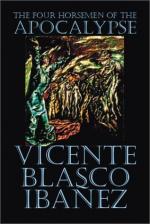An old commandant in charge of the section came out to meet them. Desnoyers thought that he must be the floorwalker of some big department store in Paris. His manners were so exquisite and his voice so suave that he seemed to be imploring pardon at every word, or addressing a group of ladies, offering them goods of the latest novelty. But this impression only lasted a moment. This soldier with gray hair and near-sighted glasses who, in the midst of war, was retaining his customary manner of a building director receiving his clients, showed on moving his arms, some bandages and surgical dressings within his sleeves, He was wounded in both wrists by the explosion of a shell, but he was, nevertheless, sticking to his post.
“A devil of a honey-tongued, syrupy gentleman!” mused Don Marcelo. “Yet he is undoubtedly an exceptional person!”
By this time, they had entered into the main office, a vast room which received its light through a horizontal window about ten feet wide and only a palm and a half high, reminding one of the open space between the slats of a Venetian blind. Below it was a pine table filled with papers and surrounded by stools. When occupying one of these seats, one’s eyes could sweep the entire plain. On the walls were electric apparatus, acoustic tubes and telephones—many telephones.
The Commandant sorted and piled up the papers, offering the stools with drawing-room punctilio.
“Here, Senator Lacour.”
Desnoyers, humble attendant, took a seat at his side. The Commandant now appeared to be the manager of a theatre, preparing to exhibit an extraordinary show. He spread upon the table an enormous paper which reproduced all the features of the plain extended before them—roads, towns, fields, heights and valleys. Upon this map was a triangular group of red lines in the form of an open fan; the vertex represented the place where they were, and the broad part of the triangle was the limit of the horizon which they were sweeping with their eyes.
“We are going to fire at that grove,” said the artilleryman, pointing to one end of the map. “There it is,” he continued, designating a little dark line. “Take your glasses.”
But before they could adjust the binoculars, the Commandant placed a new paper on top of the map. It was an enormous and somewhat hazy photograph upon whose plan appeared a fan of red lines like the other one.
“Our aviators,” explained the gunner courteously, “have taken this morning some views of the enemy’s positions. This is an enlargement from our photographic laboratory. . . . According to this information, there are two German regiments encamped in that wood.”
Don Marcelo saw on the print the spot of woods, and within it white lines which represented roads, and groups of little squares which were blocks of houses in a village. He believed he must be in an aeroplane contemplating the earth from a height of three thousand feet. Then he raised the glasses to his eyes, following the direction of one of the red lines, and saw enlarged in the circle of the glass a black bar, somewhat like a heavy line of ink—the grove, the refuge of the foe.




